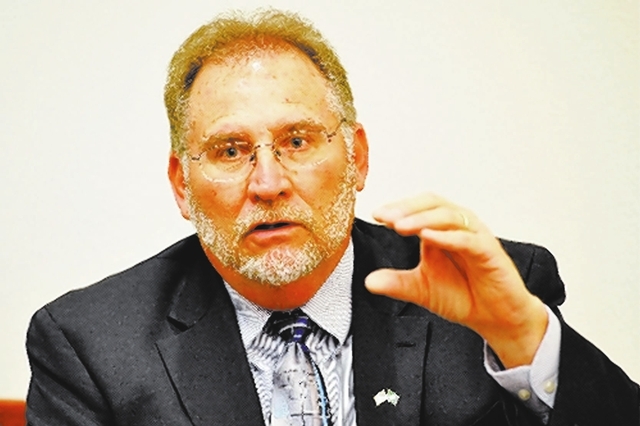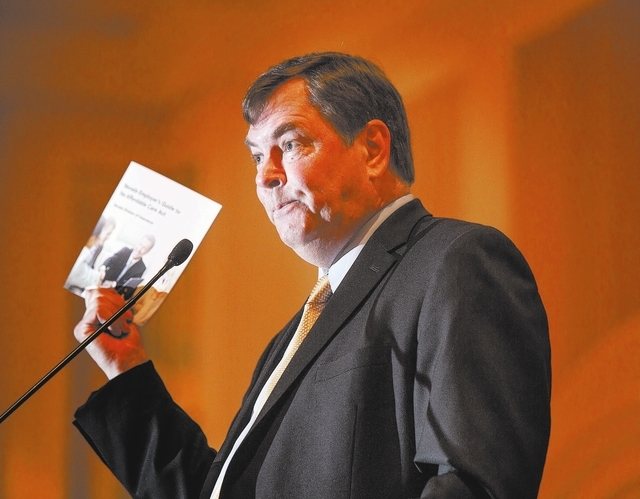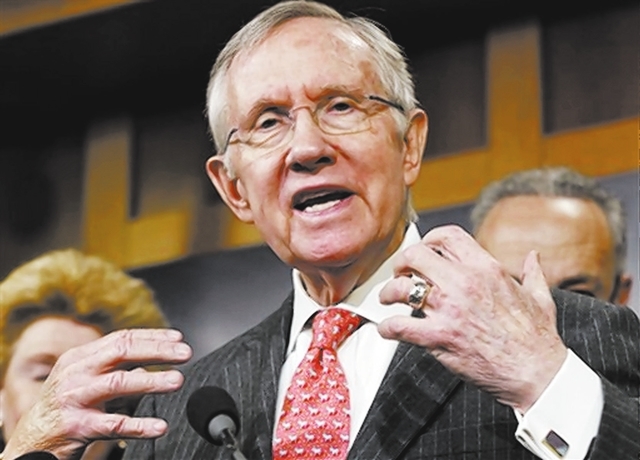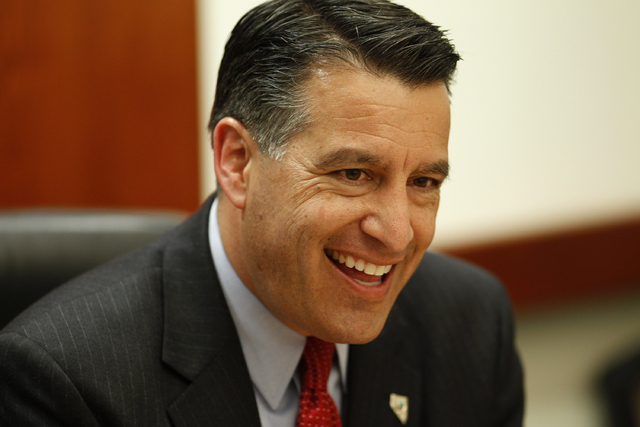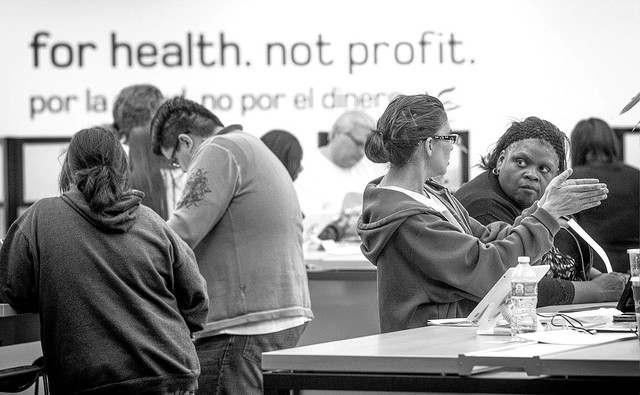Obamacare’s winners and losers in the Silver State
This game’s a long way from over, but it’s never a bad time to check the score.
The first open-enrollment session under the Affordable Care Act closed on March 31, so we’re taking a timeout to evaluate the law’s early progress in Nevada.
From state officials to insurance carriers, some groups and individuals have fared better than others as the first consumers bought plans through the Silver State Health Insurance Exchange’s Nevada Health Link website. But it’s not too late for a momentum shift. Key players already are drawing up game plans for the next open enrollment session, in November. Play things right, and the fortunes of the exchange and some of the people involved in it could improve.
For now, here’s an early look at the winners and losers.
WINNERS
Mike Willden, director of the Nevada
Department of Health and Human Services
Willden, whose department handles Medicaid enrollments, has had his own challenges.
But his transparency and his willingness to help others have made him universally liked in the insurance industry. The board of the Silver State Health Insurance Exchange even asked Willden to step in as an interim co-executive director after Jon Hager announced his resignation in February.
Willden deferred, but as a nonvoting member of the exchange board, he’s quick to offer advice and resources.
It was his suggestion to bring in Deloitte Consulting to look at how to fix the technical problems of Nevada Health Link. He offered up a deputy, Steve Fisher of the Division of Welfare and Supportive Services, as interim exchange director, and has volunteered other staff to help with technical issues and project management.
“Mike has always been accessible and easy to talk to,” said Dwight Mazzone, a Las Vegas insurance broker who’s on the exchange’s Consumer Assistance Task Force. “He’s been a good, calming influence. If I had to grade him, I would give him an ‘A’ or an ‘A-’.”
Even Gov. Brian Sandoval had high praise for Willden, calling him in March “one of the most sensitive people” he knows.
Willden is busy with his own enrollment issues, namely a 50,000-application Medicaid backlog.
But he’s scored transparency points, acknowledging publicly that it will take months to clear the paperwork.
Nor has he been slow to add staff: His agency has hired nearly 250 employees to process applications, and he’s working with state officials to bring on another 150 earlier than scheduled.
Scott Kipper, Nevada Insurance Commissioner
Kipper, another nonvoting member of the exchange board, has been a steady hand behind the scenes. His leadership has been sure enough that some insurance brokers wanted him to take over the ailing exchange when Hager stepped down.
Kipper’s agency vetted new plans for fair rates and interceded when cases went awry, submitting a letter urging Health Plan of Nevada to cover a Las Vegas man who chose its plan but went months without coverage after the exchange mixed up payments.
Kipper also implemented some of the nation’s toughest standards on licensing of enrollment counselors and navigators. Where the federal government had no certification standards, Kipper’s agency requires criminal background checks, fingerprints and continuing education.
The program wasn’t foolproof: The National Review and the Las Vegas Review-Journal sued the division in January to obtain records on enrollment experts and found that eight of more than 100 navigators had a criminal past.
Still, local insurance broker Frank Nolimal said he doesn’t consider the problem a major “black eye” for Kipper.
“It’s like anything: If somebody wants something bad enough, they’re going to hide their background,” he said. “There are people who have figured out how to circumvent the system.”
“Scott is a very forthright person. We admire him,” Nolimal added.
Kipper will have to turn his leadership in coming weeks to yet another test: Evaluating 2015 exchange plans as insurers roll out premiums and policies for November’s open enrollment.
The Old, the Sick and the Low-Income
Obamacare has been a mixed bag for consumers, but some groups have come out ahead. Nevadans who are older, unhealthy or poor have access to coverage they could never have afforded before Jan. 1.
People who were insured through plans under the federal Health Insurance Portability and Accountability Act caught an especially big break, said Larry Harrison, a local spokesman for the National Association of Health Underwriters and an independent broker with National Healthcare Access. The plans, designed for people who lost employer-sponsored coverage and ran out of extended COBRA benefits, were costing their mostly sick members as much as $1,100 a month, with a maximum out-of-pocket cost of $4,500 a year. But an exchange plan can drop that to around $700 a month with as little as $2,000 out of pocket, Harrison said.
Small groups consisting mostly of unhealthy people have received big help as well, said Brent Leavitt of Nevada Benefits, the firm that has enrolled the most people in exchange plans. Those groups typically paid 175 percent of the standard premium rate before Jan. 1, Leavitt said, but they pay closer to the standard now, thanks to rules that limit how much more insurers can charge the sick.
And singles in their 50s and 60s making $16,000 to $40,000 a year get big help through tax credits to pay for premiums and cost-sharing reductions covering out-of-pocket costs. A family of four making $30,000 to $80,000 a year also gets “a pretty decent subsidy,” Leavitt said.
Brokers and Navigators
The Affordable Care Act has so far been a business bust for insurance brokers, as well as for some firms that employ enrollment navigators and counselors. But what they’re missing in additional revenue, they’ve more than made up for in image-building. The companies still standing are now positioned to help enrollment in the state exchange at least through early 2015.
Brokers weren’t even part of the discussion when Affordable Care Act s implementation started in 2010. But state officials decided in 2012 that brokers could help market new plans, so the Division of Insurance established a certification program for agents who want to sell exchange-based coverage. About 1,500 signed up.
The exchange also awarded grants to seven community groups that trained and hired enrollment facilitators and navigators.
For brokers, sign-ups have been “not even a fraction” of expectations, said Lydia Boske, a broker with Nevada West Business Insurance and president of the Clark County Association of Health Underwriters. Most brokers wrote just 20 to 50 new plans in a system that projected 118,000 sign-ups between October and April. Nor was the effort always worth it: A single enrollment could take an hour or more, compared with 20 minutes off-exchange, Boske said.
But as consumers struggled with website issues and coverage verification, brokers and navigators turned into something else: advocates. They called meetings with Xerox and exchange officials to push for an end to clients’ sign-up troubles. They enrolled people for free in Medicaid. Even Nevada Health Link began sending people with enrollment questions to brokers and navigators.
Now, Xerox is making brokers a primary part of their outreach during a special enrollment session that began Tuesday and runs through May 30. And the exchange board on Thursday will discuss boosting navigator funding 30 percent for the three groups that did the most business.
“Financially, it’s probably not the best return on investment, but a majority of people in this marketplace are not so single-minded that they’ll only help people if they make a buck,” Boske said. “It’s worth it because there’s another group of people we had not been able to provide an insurance product to, and now we have a place for them.”
LOSERS
The Uninsured
We’re not saying it’s too late to help Nevada’s uninsured or that future enrollment sessions won’t capture more of the state’s uncovered.
But the first few months of enrollment didn’t dramatically reduce the state’s share of people lacking a health plan.
That’s a problem because Nevada has one of the nation’s highest rates of uncovered people: 621,000, or nearly 25 percent of 2.7 million residents, according to the Kaiser Family Foundation and the Census Bureau.
The state’s Medicaid members jumped about 80,000 from June to February, the latest month with available figures. The Nevada Department of Health and Human Services doesn’t break out numbers, but at least some of those 80,000 fall under the Affordable Care Act’s extension of Medicaid to childless, single adults. State officials estimated about 78,000 Nevadans would qualify for expanded Medicaid, along with natural population growth among the already-eligible.
Through Nevada Health Link, 22,533 consumers had paid for private coverage as of March 15. That’s not quite enough to offset the 25,000 or so Nevadans who saw plans canceled in the fall as new benefit mandates took effect.
The state Division of Insurance doesn’t yet know how many people who bought through the exchange were uninsured before, but a March report from consultant McKinsey &Co. estimated that roughly 75 percent buying on exchanges nationwide were already insured.
Even if all exchange and Medicaid enrollees were previously uninsured, the number of Nevada’s newly insured under the Affordable Care Act would be 102,000. That leaves the state with more than 500,000 uninsured, or 19 percent. That would still rank in the nation’s top 15 even if no other states cut their rate of uninsured residents. And other states probably have reduced their uninsured.
Those numbers might look better a year from now: The state Division of Welfare and Supportive Services will keep enrolling new Medicaid members through 2014, and officials forecast about 100,000 more sign-ups by June 2015. Plus, exchange officials have promised a more functional Nevada Health Link when the system reopens in November.
Brian Sandoval, Nevada governor
Sandoval is in the losers column because there’s no “couldn’t-win” category.
Sandoval opposed passage of the Affordable Care Act. Yet he made national headlines in 2012 as the first Republican governor to both agree to a state-run exchange and give the nod to expanding Medicaid.
Regardless of his decision on the exchange, Sandoval was likely to take flak. Open a flawed system, and he’d be held accountable for enrollment problems. Throw in with the federal version, which had its own disastrous rollout, and Nevadans would ask why the state didn’t take control of its own destiny.
“Either the federal government was going to do it, or the state would have to do it ourselves,” Sandoval told Capital Public Radio in Sacramento, Calif., in November 2012. “And Nevadans are fiercely independent, so we made a decision to build the exchange ourselves, and we are moving forward with that.”
Some members of the insurance industry praised his decision as a bold departure from other Republican governors, many of whom balked at opening exchanges and boosting Medicaid access.
Now, Sandoval is doing damage control, reaching out to media to explain how he’s riding herd on exchange contractor Xerox to get the company to perform.
Fortunately for Sandoval, no big-name Democrat stepped forward to challenge his November re-election, said David Damore, a UNLV political science professor. But the governor’s name routinely lands on the short list of potential Republican vice presidential candidates in 2016, and his decision could come back to haunt any national aspirations he might have, Damore said.
“(Obamacare) is one of those issues for a lot of Republicans, and you don’t want to be seen as embracing the president’s policy,” he said.
Harry Reid, Senate Majority Leader D-Nev.
Reid wasn’t in on Nevada’s decision to start its own exchange, but as leader of the Senate Democrats, he’s in a perilous position. Statistician and political forecaster Nate Silver pegs the GOP as a slight favorite to take over the Senate in 2014, and University of California, Davis political scientists writing in the Washington Post gave Republicans “solid” odds of reclaiming the chamber.
The rollout of the exchanges could be a big driver for Republicans in November: The law was the top issue in a March 11 special election in Florida that went the GOP’s way.
If the Senate swings right, Reid loses the majority and control of what happens there.
Regardless of who’s running the Senate, Damore doesn’t think Reid will lose his job as the Democrats’ leader.
“He’s too well-liked, and he does a good job with his caucus,” he said.
And two years is forever in politics, so Damore predicts other issues will sit on the front burner by the time Reid begins campaigning in earnest for re-election in 2016. Still, Reid practically handed future opponents a campaign ad when he stood on the Senate floor on Feb. 26 and said “all” Obamacare “horror stories” were “untrue,” even as his office was fielding phone calls from a Las Vegas man hit with more than $400,000 in medical bills because of a coverage mix-up.
“Probably in hindsight, that was an unfortunate thing to say,” Damore said. “But it was just another one of those Reid-isms. A lot of those stories have been disproven, but the picture is not as rosy as he’d like to paint it.”
The Young and Healthy
National and state numbers show people younger than 35 have yet to embrace Affordable Care Act-related plans. Less than 30 percent of exchange enrollees come from the “young invincible” set.
That’s because premiums have jumped for young adults, Harrison said. He said he’s seen individual plans for the young go from $89 a month and a maximum of $2,000 out of pocket in 2013 to $200 a month and out-of-pocket costs of as much as $6,250.
“Mandates are the enemy. Everybody has to pay for maternity coverage, which we used to be able to carve out. Everybody has to pay for pediatric dental care,” Harrison said.
New regulations also restrict the cost gap between premiums for the young and the old. Where some insurers could charge six times more before 2014, the law now allows no more than three times the difference. Insurers have raised younger members’ rates to close the gap.
Young families making $50,000 to $100,000 a year also are feeling the hurt, Leavitt said. A $400-a-month rate that covered a spouse and three children before Jan. 1 now can cost as much as $1,000 because flat family rates have been replaced by per-child rates, and adult males have to pay for maternity benefits.
Insurers
Insurance carriers were on board with the law early, helping the Obama administration write regulations they thought would bring a bonanza of new business.
But the law has evolved since 2010 in ways that have given insurers fits. After carriers in November canceled more than 5 million plans — including 25,000 Nevada policies — because they didn’t meet benefit requirements, the White House asked insurers to reinstate the plans.
The Nevada Division of Insurance avoided whiplash by telling carriers that reviving the plans would be illegal.
But Nevada insurers were thrown another curve ball when the state exchange decided to extend enrollment through May 30 for tens of thousands of Nevadans who started to apply for a plan but never pressed “pay.” Insurers based their rates on a sign-up session that would end March 31; not only are they exposed to unexpected, late sign-ups, but they’ll have less time to set plans and premiums for 2015.
They’re also dealing with Obamacare-imposed limits on administrative spending — a problem when the state exchange is still sending them paper enrollments and payments to enter manually, adding to their costs.
Worst of all for insurers, they become the punching bag when consumers run into plan-related trouble, Harrison said. A glitch at the exchange that causes verification problems, a billing mistake at the doctor’s office that keeps claims from being paid — it all blows back on carriers.
“People get angry. They get frustrated, and they don’t even know who they’re mad at. But the insurance company is at the front line,” Harrison said. “People like their doctor. So they say, ‘I’m gonna get mad at this insurance company because they didn’t pay my claim.’ ”
Contact reporter Jennifer Robison at jrobison@reviewjournal.com or 702-380-4512. Follow @J_Robison1 on Twitter.



